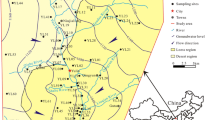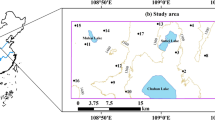Abstract
Groundwater recharge using reclaimed water has developed rapidly around the world to relieve the groundwater resource shortage and declining of the water table. Traditional water treatment systems are inefficient to remove all the types of contaminants, so it is urgent to identify the priority chemical substances (CSs) that deserve our first concern. In this study, we developed a method (EER method) to identify priority CSs in groundwater recharge by surface spreading and direct aquifer injection. Three stages were processed which were exposure assessment, effect assessment and ranking for identification of priority CSs. Fourteen cities in China were selected for data collected and 90 pollutants in reclaimed water samples were analyzed as the target pollutants for a case study. According to three stages, the 90 CSs studied were divided into five groups (primary control CSs and high, moderate and low and no risk control CSs). In the primary control CSs and high, moderate and low and no risk control CSs group there were 14, 18, 21, 21 and 16 CSs, respectively when groundwater recharged by surface spreading, while there were 15, 18, 21, 21 and 15 CSs when recharged by direct injection. This method provided an indicator of prioritizing the risk of 90 compounds in the reclaimed water for groundwater recharge.



Similar content being viewed by others
References
Antonio Rodriguez-Liebana J, Elgouzi S, Dolores Mingorance M, Castillo A, Pena A (2014) Irrigation of a Mediterranean soil under field conditions with urban wastewater: effect on pesticide behaviour. Agric Ecosyst Environ 185:176–185
Arnot JA, Mackay D (2008) Policies for chemical hazard and risk priority setting: can persistence, bioaccumulation, toxicity, and quantity information be combined? Environ Sci Technol 42:4648–4654
Baun A, Eriksson E, Ledin A, Mikkelsen PS (2006) A methodology for ranking and hazard identification of xenobiotic organic compounds in urban stormwater. Sci Total Environ 370:29–38
Castiglioni S, Fanelli R, Calamari D, Bagnati R, Zuccato E (2004) Methodological approaches for studying pharmaceuticals in the environment by comparing predicted and measured concentrations in River Po, Italy. Regul Toxicol Pharmacol 39:25–32
China (2006) Standard for drinking water quality
Dabrowski JM, Shadung JM, Wepener V (2014) Prioritizing agricultural pesticides used in South Africa based on their environmental mobility and potential human health effects. Environ Int 62:31–40
Gouin T (2010) The precautionary principle and environmental persistence: prioritizing the decision-making process. Environ Sci Policy 13:175–184
Guo GH, Wu FC, He HP, Zhang RQ, Li HX (2013) Screening level ecological risk assessment for synthetic musks in surface water of Lake Taihu, China. Stoch Environ Res Risk Assess 27:111–119
HSDB (2014) Hazardous substance data bank
Karnjanapiboonwong A, Suski JG, Shah AA, Cai QS, Morse AN, Anderson TA (2011) Occurrence of PPCPs at a wastewater treatment plant and in soil and groundwater at a land application site. Water Air Soil Pollut 216:257–273
Koeck-Schulmeyer M, Ginebreda A, Postigo C, Garrido T, Fraile J, Lopez De Alda M et al (2014) Four-year advanced monitoring program of polar pesticides in groundwater of Catalonia (NE-Spain). Sci Total Environ 470:1087–1098
Kumar A, Xagoraraki I (2010) Pharmaceuticals, personal care products and endocrine-disrupting chemicals in US surface and finished drinking waters: a proposed ranking system. Sci Total Environ 408:5972–5989
Kwon J, Rodriguez JM (2014) Occurrence and removal of selected pharmaceuticals and personal care products in three wastewater-treatment plants. Arch Environ Contam Toxicol 66:538–548
Leitao S, Moreira-Santos M, Van den Brink PJ, Ribeiro R, Jose Cerejeira M, Sousa JP (2014) Ethoprophos fate on soil-water interface and effects on non-target terrestrial and aquatic biota under Mediterranean crop-based scenarios. Ecotoxicol Environ Saf 103:36–44
Mahmoudi M, Rahnemaie R, Es-haghi A, Malakouti MJ (2013) Kinetics of degradation and adsorption–desorption isotherms of thiobencarb and oxadiargyl in calcareous paddy fields. Chemosphere 91:1009–1017
Neuparth T, Moreira S, Santos MM, Reis-Henriques MA (2011) Hazardous and noxious substances (HNS) in the marine environment: prioritizing HNS that pose major risk in a European context. Mar Pollut Bull 62:21–28
Oliveira RS, Alonso DG, Koskinen WC, Papiernik SK (2013) Comparative sorption, desorption and leaching potential of aminocyclopyrachlor and picloram. J Environ Sci Health Part B Pestic Food Contam Agric Wastes 48:1049–1057
Pedretti D, Barahona-Palomo M, Bolster D, Fernandez-Garcia D, Sanchez-Vila X, Tartakovsky DM (2012) Probabilistic analysis of maintenance and operation of artificial recharge ponds. Adv Water Resour 36:23–35
Peluso F, Dubny S, Othax N, Castelain JG (2014) Environmental risk of pesticides: applying the DelAzulPestRisk model to freshwaters of an agricultural area of Argentina. Human Ecol Risk Assess 20:1177–1199
Perazzolo C, Morasch B, Kohn T, Magnet A, Thonney D, Chevre N (2010) Occurrence and fate of micropollutants in the Vidy Bay of Lake Geneva, Switzerland. Part I: priority list for environmental risk assessment of pharmaceuticals. Environ Toxicol Chem 29:1649–1657
Qiu J (2010) China faces up to groundwater crisis. Nature 466:308
Rebhun M (2004) Desalination of reclaimed wastewater to prevent salinization of soils and groundwater. Desalination 160:143–149
Schriks M, Heringa MB, van der Kooi M, de Voogt P, van Wezel AP (2010) Toxicological relevance of emerging contaminants for drinking water quality. Water Res 44:461–476
Snyder EM, Snyder SA, Giesy JP, Blonde SA, Hurlburt GK, Summer CL et al (2000) SCRAM: a scoring and ranking system for persistent, bioaccumulative, and toxic substances for the North American Great Lakes—Part I. Structure of the scoring and ranking system. Environ Sci Pollut Res 7:52–61
Sui Q, Wang B, Zhao WT, Huang J, Yu G, Deng SB et al (2012) Identification of priority pharmaceuticals in the water environment of China. Chemosphere 89:280–286
Tartakovsky DM (2013) Assessment and management of risk in subsurface hydrology: a review and perspective. Adv Water Resour 51:247–260
Tartakovsky DM (2007) Probabilistic risk analysis in subsurface hydrology. Geophys Res Lett 34:L05404
Teijon G, Candela L, Tamoh K, Molina-Diaz A, Fernandez-Alba AR (2010) Occurrence of emerging contaminants, priority substances (2008/105/CE) and heavy metals in treated wastewater and groundwater at Depurbaix facility (Barcelona, Spain). Sci Total Environ 408:3584–3595
USEPA Office of Pesticide Programs, Health Effects Division, Science Information Management Branch (2006) Chemicals evaluated for carcinogenic potential
Yang J (2006) Leaching of heavy metals in soil column under irrigation reclaimed water: a simulation experiment. Geogr Res 25:449–456
Yu Y, Song X, Zhang Y, Zheng F, Liang J, Han D et al (2013) Identification of key factors governing chemistry in groundwater near the water course recharged by reclaimed water at Miyun County, Northern China. J Environ Sci China 25:1754–1763
Li Z, Li M, Liu X (2014) Preliminary screening and ecological risk assessment of organic compounds in groundwater recharge of China. J Hazard Mater (under review)
Acknowledgments
The authors thank the National Natural Science Foundation of China (No. 51378287) and the Special Environmental Research Funds for Public Welfare (No. 201209053) for the financial support of this work.
Author information
Authors and Affiliations
Corresponding authors
Appendix
Appendix
See Table 5.
Rights and permissions
About this article
Cite this article
Li, Z., Xu, C., Li, M. et al. Identification and assessment of water safety risk for groundwater recharge with reclaimed water in China. Stoch Environ Res Risk Assess 31, 1671–1682 (2017). https://doi.org/10.1007/s00477-016-1313-8
Published:
Issue Date:
DOI: https://doi.org/10.1007/s00477-016-1313-8




